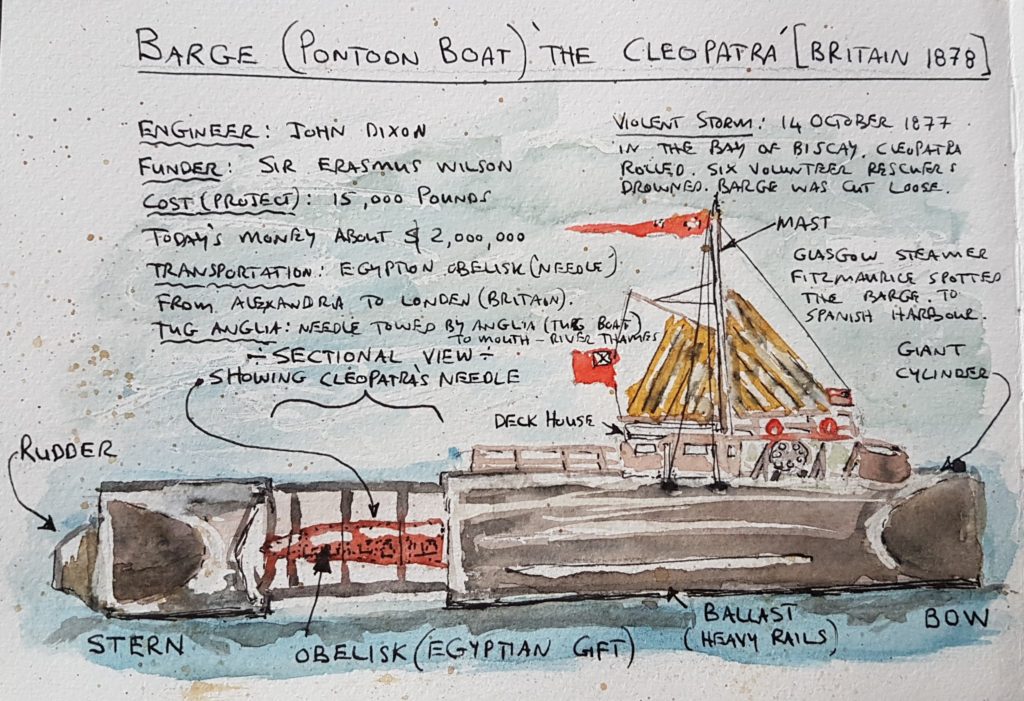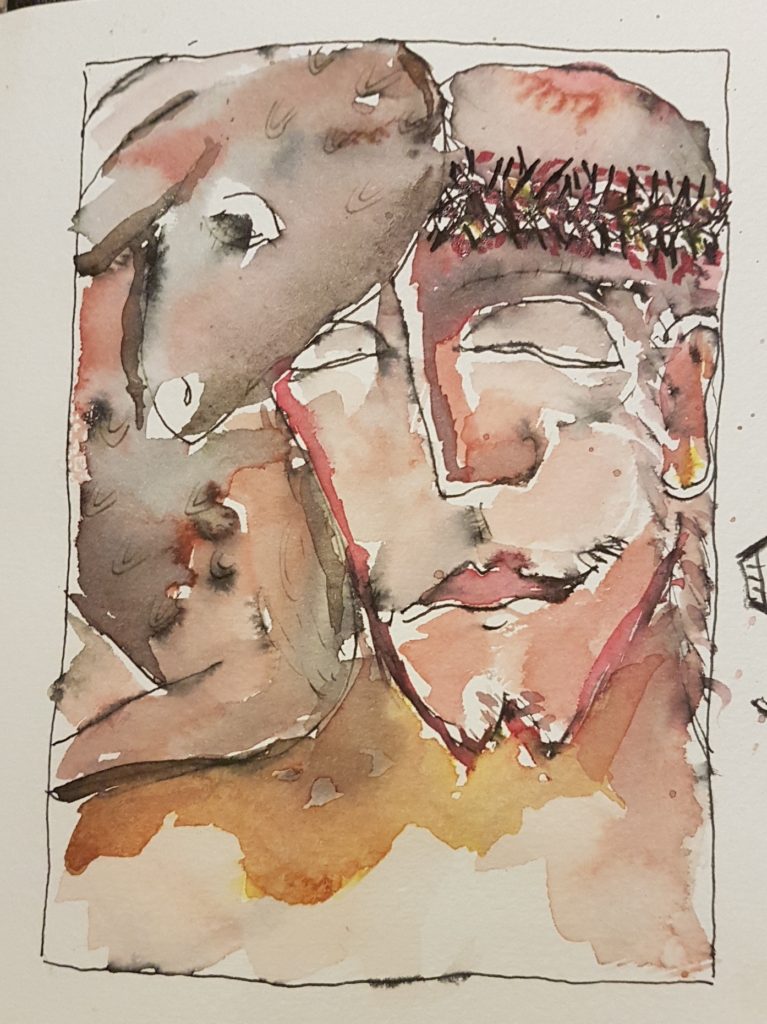
By William Van Zyl (2021)
The cylindrical coffin rolled over – slowly. It is as if a crocodile is doing a death-roll on its prey. As it rolls over, the brown rusted underbelly of the beast is suddenly exposed – rows of pan head rivets studded the tummy. The body is incarcerated. Some of the rusted and battered plates are covered with sharp barnacles and seaweed. The heavy ballasts in the base of the coffin pulled sideways with all its might to hold it up; but, the storm had other plans. It had violent intentions. It wanted to roll the coffin over and over – Davy tried to swallow it. The casket – and the body inside – fought back in the rough seas.
Unwittingly the fate of the body was written on the needle. Intricate shapes and forms covered the body – ‘tattooed’ in an unknown code – not a letter or a number found amongst the inscriptions. It told a story – a story of ancients. Three-thousand-five hundred-year-old secrets were chiseled into the body. Was there a curse on the body? The storm was relentless; it wanted to destroy the coffin and the body. Davy Jones’ locker waited patiently for the body to sink into the depths. The hostile storm wished to send the ancient body deep down to the black, cold, and murky vault.
The body and the coffin were cut loose by an anxious captain, fearing for his men’s lives and his own. The captain had lost already 6 of his men. He had to let go. The casket was now at the mercy of the sea. The body bobbed up and down in the hostile white foam.
On day six – it was calmer – a friendly steamer spotted the drifting coffin. The surprised captain’s voice was filled with perplexion.
“What is a large coffin doing adrift in the ocean?” he asked. His brass telescope glistened in the sun and enlarged the coffin; he could see the belly of the coffin. He was perplexed. Who had left the colossal coffin in the ocean?
The captain towed the coffin back to shore; he would investigate later.

The captain entered the floating tomb. The torch-lit intestines of the dead body revealed a secret. It was a needle.
“What on earth!” the captain gasped.
He touched the needle; the body was ice cold. His fingers followed the strange inscriptions on the 20-meter-long needle.
Table of Contents
The true story:
After the needle was found adrift at sea, it was taken to its intended destination in 1887–London in the UK.
Here is the story: The needle was a gift to Britain by Egypt. The needle was erected at the mouth of the Thames River in London. It is the oldest artefact in London today – almost 3500 years old.
The events on the day the pontoon was cut loose: Six sailors lost their lives on the fateful day the barge boat was left in the ocean before it was discovered by the friendly steamboat. It was safely towed to land.
This is the story of Cleopatra’s needle carried in a barge (boat) which was cut loose in a violent storm by a distressed captain. The barge was towed by a steamboat. After the captain lost 6 of his men – who volunteered to save the crew from the pontoon boat – the captain decided to abandon the coffin. The fateful small rowboat was swamped, and the six men perished. The pontoon boat was discovered about 6 days later and towed to the nearest shore.
Today the Egyptian obelisk stands as a landmark in London; it towers over 2o meters into the sky. It sings - in hieroglyphic form; it tells of the mighty deeds of the Pharaohs. It sings the praises of Ramses the second. It also magnifies and honours the Egyptian gods and Pharaohs of the past. The inscriptions illustrated the history of Egypt very extravagantly…


Exploring more Symbols (‘needles’): The ancient Israelites – slaves in Egypt – during the time of Moses
The Israelites had the Egyptian Empire – their culture and extravagant gods and Pharaohs – as a reference.
What ‘needle’ or ‘obelisk’ would the Israelites erect?
The Israelites lived in Egypt for 430 years before Moses led them out of bondage. While wandering in the desert for 40 years, it had me thinking: Why did they choose to make a golden calf and worship it?
They lived an elementary life moving through the desert collecting food every day (manna and quail). While Moses was on Mount Sinai, they decided to build a golden calf (a reference to Egypt).
The Golden Calf
Exodus 32 (verse 1 -3). When the people saw that Moses was so long in coming down from the mountain, they gathered around Aaron and said, “Come, make us gods who will go before us. As for this fellow Moses who brought us up out of Egypt, we don’t know what has happened to him.”
2 Aaron answered them, “Take off the gold earrings that your wives, your sons and your daughters are wearing, and bring them to me.” 3 So all the people took off their earrings and brought them to Aaron. 4 He took what they handed him and made it into an idol cast in the shape of a calf, fashioning it with a tool. Then they said, “These are your gods, Israel, who brought you up out of Egypt.”
Can you imagine what Jehovah (God) must have experienced while seeing His people making an idol to worship? They rejected Him. It must have been very disappointing to the Almighty. Interesting that during that time, the desire to worship something was powerful. They wanted to worship something. Something they could see. Something that they have seen being influential in the Egyptian culture.
Also, the golden calf was a symbol of virility and strength associated with the Canaanite god El, and such idolatry would persist into the period of the divided monarchy. King Jeroboam I of the Northern Kingdom of Israel commissioned two golden calves for the sanctuaries of Yahweh in Bethel and Dan to serve as the Lord’s attendants.
The Israelites have seen the Egyptian gods and how mighty the Pharaohs were. The Egyptians prospered in every area. They were impressed by the grandeur of their culture and religion.
Reflect on this:
So, the question is, what are Christians worshipping today? What are the needles or obelisks of Christianity? Crosses, images of Jesus, or maybe cathedrals? I suggest something else.
Did you know: The image of The Good Shepherd, often with a sheep on his shoulders, is the most common of the symbolic representations of Christ found in the Catacombs of Rome, and it is related to the Parable of the Lost Sheep.
Maybe the lost sheep on the shoulders of Jesus could be a great choice for a needle or obelisk for Christianity? What do you think?
Contrast: Cleopatra’s Needle and The Lost Sheep
Think about this contrast: An abandoned coffin at sea with an Egyptian Obelisk found by a steamboat in 1887 and a lost sheep found by the Good Shepherd in John 10:1–21.
“I am the good shepherd. The good shepherd lays down his life for the sheep.”
Shrek – the lost sheep from New Zealand
A true story. Related to The Good Shepherd – a lost sheep, found.

Shrek –the lost sheep –shorn. When the lost sheep was found after 6 long years, not only did the owner celebrate, when the nation of New Zealand “got wind” of Shrek, he became a national icon. Shrek got to meet the then Prime Minister of New Zealand Helen Clark at the national parliament in Wellington. He became famous in children’s books, postcards and videos. People were so interested in Shrek’s return, the owner kept him in air-conditioned comfort for a few weeks so that reporters could broadcast this amazing return of the lost sheep. Then, on live television broadcast nationally throughout New Zealand and taped versions broadcast internationally on CNN and BBC, world champion sheep-shearer Peter Casserly shaved off six years’ worth of matted wool. The 60 pounds of wool was auctioned off at record high prices for charity. Source: https://mysundayblog.com/2019/03/31/the-lost-sheep/
Think about the weight Shrek lost (the wool). The Gospel says:
Rest for the Weary
28 Come to Me, all you who are weary and burdened, and I will give you rest. 29 Take My yoke upon you and learn from Me; for I am gentle and humble in heart, and you will find rest for your souls. 30 For My yoke is easy and My burden is light.” Matthew 11: 28 – 30
Berean Study Bible

More images related to this article

A Golden Calf.
The Rosetta Stone – deciphering the Egyptian Code
How did they decipher the inscriptions on the Cleopatra’s needle?

The Rosetta Stone is a granodiorite stele inscribed with three versions of a decree issued in Memphis, Egypt, in 196 BC during the Ptolemaic dynasty on behalf of King Ptolemy V Epiphanes. The top and middle texts are Ancient Egyptian using hieroglyphic and Demotic scripts, respectively, while the bottom is Ancient Greek. The decree has only minor differences between the three versions, making the Rosetta Stone key to deciphering the Egyptian scripts. By Rick Dikeman – Own work, CC0, https://commons.wikimedia.org/w/index.php?curid=59286429

The Rosetta Stone. The important thing for us is that the decree is inscribed three times, in hieroglyphs (suitable for a priestly decree), Demotic (the native Egyptian script used for daily purposes, meaning ‘language of the people’), and Ancient Greek (the language of the administration – the rulers of Egypt at this point were Greco-Macedonian after Alexander the Great’s conquest).

Egyptian Hieroglyphs. Pixabay.

Close up of the Inscriptions on the Egyptian obelisk. London, UK.

The base of Cleopatra’s obelisk – London, UK.
Copyright © 2021 by William Van Zyl
A cold, dead body lays in the dark rusted belly of a coffin – tattooed from head to toe with a secret message – it floats with the will to survive. Will Davy Jones swallow it?
All rights reserved. This book or any portion
thereof may not be reproduced or used in any manner
whatsoever without the express written permission of the
publisher except for the use of brief quotations in a book review.
Published by Five House Publishing (New Zealand)
First Publishing, 2021

More ebooks and articles available at https://fivehousepublishing.com/
More about the author at http://williamvanzyl.com/